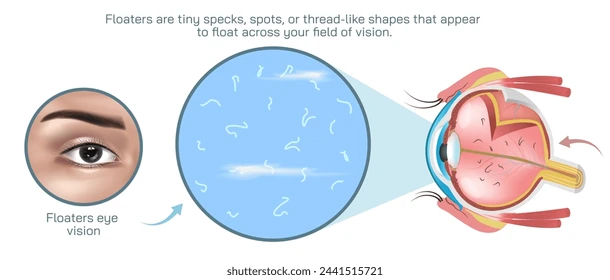
What are floaters?
Eye floaters are those small spots, threads, or cobweb-like shapes that float around in your field of vision, especially when looking at a bright, plain background like the sky or a white wall. They’re often more noticeable when you're looking at something bright or when your surroundings are uniform, and they move as you move your eyes.
Floaters are usually harmless and are often caused by age-related changes in the vitreous humor, the gel-like substance that fills the inside of your eye. As we age, the vitreous can shrink and become more liquid, causing tiny fibers to clump together and cast shadows on the retina, which you perceive as floaters.
However, if you notice a sudden increase in floaters, especially if they’re accompanied by flashes of light or a loss of peripheral vision, it’s important to see an eye doctor. This could be a sign of a more serious condition like a retinal tear or detachment.
Causes of Eye Floaters
Aging (Most Common Cause)
As we get older, the vitreous humor (the gel-like substance that fills the eye) can shrink and become more liquid. This change causes tiny fibers within the vitreous to clump together, casting shadows on the retina, which we see as floaters.Retinal Detachment or Tear
A more serious cause of floaters can be a retinal detachment or tear. When the vitreous shrinks, it can sometimes tug on the retina, leading to a tear or detachment. This can cause a sudden increase in floaters, along with flashes of light. If left untreated, this can lead to permanent vision loss.Inflammation of the Eye (Uveitis)
Inflammation inside the eye, especially in the middle layer (the uvea), can cause floaters. Conditions like uveitis can release cells into the vitreous, creating floaters.Diabetic Retinopathy
High blood sugar levels from diabetes can damage the blood vessels in the retina, leading to leakage of blood or fluid into the vitreous. This can result in floaters.Eye Injury or Surgery
Any trauma to the eye or surgery (like cataract surgery) can cause floaters, either from physical changes to the eye or from bleeding into the vitreous.Myopia (Nearsightedness)
People with myopia are at a higher risk for floaters. The elongated shape of the eyeball in myopia can cause the vitreous to separate from the retina more easily.Medication Side Effects
Some medications, such as those used for treating certain eye conditions (like intravitreal injections), may cause changes in the vitreous and result in floaters.Posterior Vitreous Detachment (PVD)
This is a natural age-related process where the vitreous humor pulls away from the retina. It can lead to floaters, and though it’s typically harmless, it can sometimes lead to complications.
Symptoms
Spots or Shapes
You might see spots, squiggly lines, or cobweb-like shapes that seem to float in your line of sight. These are the floaters themselves. They might appear darker or lighter depending on your background.Movement with Eye Movement
Floaters usually move when you move your eyes. They seem to "drift" in the direction you’re looking, often staying in your peripheral vision.Increased Floaters
If you notice a sudden increase in the number of floaters or if they appear more intensely, it might indicate something more serious, like a retinal tear or detachment.Flashes of Light
Flashes of light, also known as photopsia, may accompany the floaters if there’s tension on the retina or a retinal tear. These are often described as lightning-like flashes or sudden bursts of light.Blurred Vision
In some cases, especially with more severe eye conditions like retinal detachment, you might experience blurred vision in addition to floaters and flashes.Loss of Peripheral Vision
If a retinal detachment is present, floaters may be accompanied by a gradual loss of side vision or a "curtain" effect that may obscure parts of your vision.
When Should You See a Doctor?
If you notice any of the following symptoms, it's important to seek immediate medical attention:
A sudden increase in floaters.
Flashes of light, especially if they’re new.
A shadow or "curtain" over part of your vision.
Sudden vision loss.
Even though most floaters are harmless and common with aging, these warning signs could point to a retinal tear, detachment, or other serious eye condition, and early intervention is key to preventing vision loss.







